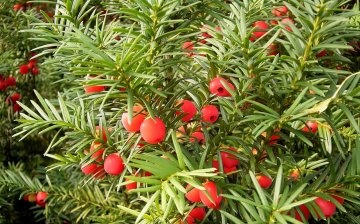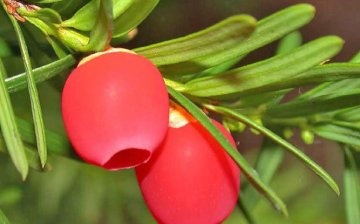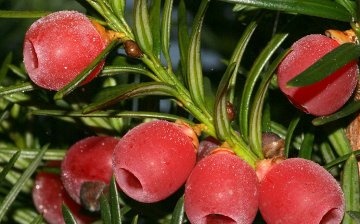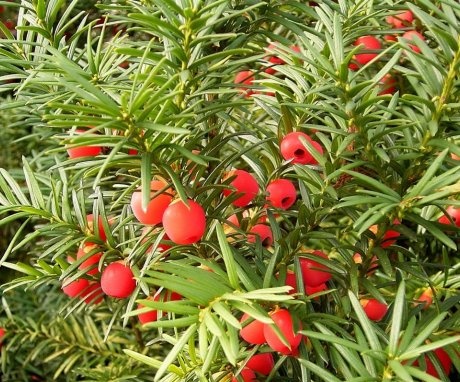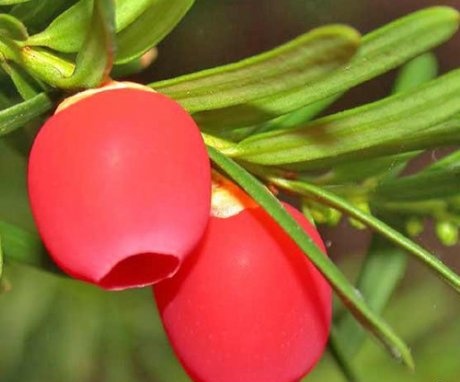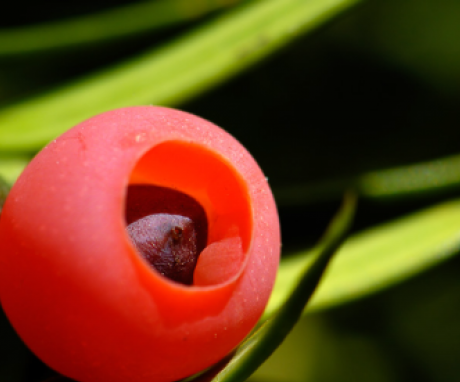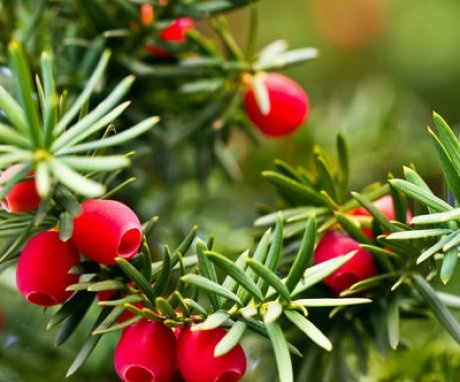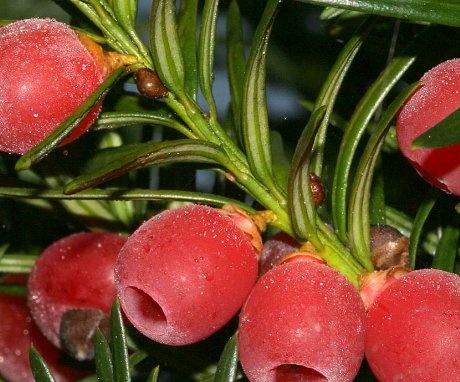Yew berry: description, varieties and agricultural technology
Yew - perennial evergreen plant belongs to the Yew family. Its homeland is Western Europe, the Caucasus, Syria and Asia Minor. In the same places are the world's largest forests of these trees and bushes.
Content:
- Description of the plant
- Berry yew varieties
- Caring for berry yew
- Reproduction of yew berry
- Plant application
Description of the plant
There are dioecious and monoecious representatives of this plant family. The needles of different types of yews vary in length from 3–10 cm in length, they are flat and have no edges, like many other conifers. The fruits are gymnosperms, similar to berries, and are red, blue or brown.
The flowering of the plant is laid in the autumn. And in spring, when the sun warms the air a little, the yew blossoms. This process usually begins in the month of April.
All parts of the yew tree are poisonous.
The bark, needles and fruits of the plant contain ephedrine and taxin, which cause poisoning in both humans and animals. The older the plant, the stronger its poison.
Berry yew varieties
The most popular varieties of berry yew:
- Yew berry Elegantissima. Perennial evergreen bush beautiful shape. At the age of 10, it grows only 1 meter. The diameter of the crown during this time grows by 1.5 meters. The branches are spreading and completely covered with needles. The needles are colored greenish-white with a yellowish tinge, its size is 1.5–2 cm in length. It stays on the branches for 6–8 years. The first 6 years the bush grows slowly, in subsequent years the growth is 25 cm in height and 25 cm in width. All parts of the bush are poisonous. It is unpretentious in leaving. Grows well in partial shade and shade, hardy.
- Yew Berry Baccata. Evergreen spherical coniferous bush. The branches grow densely, neatly, the needles are dense. The bush stretches up to 15 meters in height, and up to 10 meters in width. The needles of the needles grow 2-3 cm in length. They are painted on the upper side in a dark green tone. And in light green from the bottom. The bush grows well and develops both in the shade and in a sunny, well-lit place. It is unpretentious in leaving.
- Yew berry Samergold. In this type of yew, the bush has a wide and flat shape. It grows up to a meter in height and reaches its crown of the same size. The needles resemble a sickle in shape, grows in length by 2-3 cm. It is painted yellowish, in summer it acquires a golden hue. The plant is poisonous. In care, the bushes are unpretentious, develop well in the shade and in a sunny place, high frost resistance.
- Yew berry David. An evergreen perennial tree, the height of which reaches 2 meters, the width is 70-80 cm. The needles are oblong, sharp at the ends, grows in length by 3 cm. Ornamental, young shoots have a yellowish-lime color. Prefers moist, rich soils. But it also grows well on dry soils and in sunny places. The tree can live up to 1000 years.
- Yew berry rendance. Decorative, a perennial and evergreen variety. Shoots are branched and spreading, growing to the sides, parallel to the ground. The shape of the crown is asymmetric, but due to the density of the branches, it is dense and fluffy. The needles are painted in a pale green tone, soft to the touch, grows densely along the entire length of the branches. The bush grows quickly, the growth is 10 cm per year. It grows up to 1 meter in height, the crown of an adult bush can reach 4.5 meters.This variety of yew berry prefers bright places with good lighting, in the shade it becomes dimmer and loses its decorative effect.
- Yew berry Fastigiata. A tree whose height reaches 1.5 meters after 10 years of growth. Shoots are strongly branched, grow upward. The crown is shaped like a column. The main branches are hard, the lateral ones are smaller and softer, and needles grow densely on them. The needles are medium in size, painted in a dark green tone. Grows well in fertile moist soil. It is a heat-loving variety, therefore it is recommended to warm it for the winter.
- Berry yew Krzysztof. This is a Polish variety of berry yew. Refers to slow-growing varieties. Within 10 years, its growth reaches 1.2 meters. Shoots are straight and firm, growing vertically, so the crown forms a narrow column. The needles are medium in size, painted green at the edges, yellow. This feature gives the variety an additional decorative effect. It is unpretentious in leaving. Grows in the sun and shade.
- Yew berry FastigiataAurea. Evergreen, perennial wood, the crown of which resembles a narrow column in shape. It grows slowly. Young shoots have yellowish needles, with age it becomes green, and yellowness remains only at the edges. Grows well in partial shade.
Caring for berry yew
Choosing a place for a yew tree is simply where it needs to be planted for decorative purposes. This plant grows well in partial shade and in an open, sunny place. But there are some varieties that become more faded in the shade, this must be taken into account when planting. Also, for the formation of a uniform crown, it is desirable to have a good illumination of the plant by the sun.
The soil is preferred neutral or slightly acidic, fertile and moisture-consuming.
They grow poorly in sandy and acidic soils. There should also be good drainage and there should be no groundwater in the place where the yew grows. When planting bushes or trees, holes of 70 cm are dug in all directions. The earth is mixed with sand, lime and humus, and the roots are filled with this mixture. You can also add charcoal. After planting, the plant must be watered with a solution of mineral fertilizers.
Yew does not need watering. But during dry periods it is recommended to water plant once every 2 weeks. To do this, you need to use heated water and irrigate the plant completely, starting from the crown. It is recommended to carry out this process in the evening. It is also recommended to periodically loosen the ground under bushes and trees.
Plant feeding:
- Yew needs to be fed with organic and mineral fertilizers every year.
- In the spring, it is recommended to add compost or humus after digging, so that the substances penetrate as much as possible to the root system.
- In the summer, a mullein solution is added 2 times.
For wintering, you can insulate the root system by pouring leaves or peat under the plant, which can be dug up in the spring. This is an optional process, since almost all yew varieties winter well and can withstand frosts down to -25 degrees.
Bushes and trees need regular pruning.
This process will not be particularly difficult, since the plant develops very slowly for the first 5-7 years. However, form a crown it is necessary from the first years of the life of a tree or bush. Pruning the upper part of the shoot enhances branching. Therefore, if a dense crown is needed, this process is carried out constantly. The only caveat is that you must take into account the characteristics of each variety. Therefore, before pruning a 3-4 year old plant, it is recommended that you familiarize yourself with its characteristics and the form of growth.
Reproduction of yew berry
Reproduction by seeds:
- Seeds harvested from trees and bushes in the fall, when the berries are already fully ripe.
- After that, the fruits are immersed in water to remove the top layer and select seeds, which are dried and sent for a year for stratification. Without preparation, seeds can lie in the ground for 4 years before they begin to germinate.
- They are stratified by placing them in a room with low humidity, where the temperature is constantly maintained within 5-6 degrees.
- If the seeds are kept warm, then their germination decreases to zero.
- After a year of preparation, the seeds are densely sown in greenhouses and mulch needles.
- In spring, about 70% of the seedlings germinate.
Also, the seeds are subjected to chemical stratification... To do this, they are kept for 30 minutes in sulfuric acid, after which they are carefully washed and sown. This is necessary in order for the thick shell of the seed to weaken a little, and it was easier for the sprout to break through. You can also combine cold and chemical stratification.
Propagation by cuttings:
- For grafting, you must select a period. For this, April - May or September - October are suitable.
- Cuttings are cut 15-20 cm long from ripe branches, each should have several shoots.
- The lower part of the needles is removed and planted in boxes, which are transferred to greenhouses for the winter, cold period.
- The soil in the boxes must be filled with prepared. For this, coarse sand, peat and crushed coniferous bark are mixed.
- To accelerate root growth, it is recommended to treat the cuttings with stimulants.
- In the open field, a new tree grows from the cuttings after 7 years, if the cuttings are in the greenhouse, then the process is reduced by 2 years.
Almost all yew varieties are resistant to diseases... Problems arise with improper plant care. Occasionally, pests such as false shield and yew gall midge can appear on the branches. In order to avoid attacks of pests, it is recommended to treat the entire bush with special preparations in the spring, before bud break.
Plant application
Berry yew is widely used in landscape design... Its different varieties have a distinctive feature and high decorative value. By trimming from the crown, you can create various shapes and shapes. It is used to create compositions in gardens, flower beds.
It is widely used for landscaping city streets and squares.
Yew wood is a valuable species. It has high strength and resistance to decay, in addition, in the section, the wood has a beautiful decorative structure.
In ancient times, furniture was made from it and used in shipbuilding. But over time, the trees became less and less, and its use grew, which could lead to the complete destruction of this species. The reason for this is the long growth period of the plant. Therefore, today the yew is listed in Red Book like an endangered plant.
More information can be found in the video.




